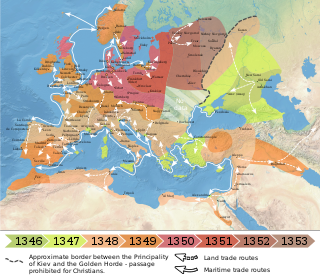
The Black Death was a bubonic plague pandemic that occurred in Europe from 1346 to 1353. It was one of the most fatal pandemics in human history; as many as 50 million people perished, perhaps 50% of Europe's 14th century population. The disease is caused by the bacterium Yersinia pestis and spread by fleas and through the air. One of the most significant events in European history, the Black Death had far-reaching population, economic, and cultural impacts. It was the beginning of the second plague pandemic. The plague created religious, social and economic upheavals, with profound effects on the course of European history.

The Great Plague of London, lasting from 1665 to 1666, was the most recent major epidemic of the bubonic plague to occur in England. It happened within the centuries-long Second Pandemic, a period of intermittent bubonic plague epidemics that originated in Central Asia in 1331, and included related diseases such as pneumonic plague and septicemic plague, which lasted until 1750.

A plague doctor was a physician who treated victims of bubonic plague during epidemics in 17th-century Europe. These physicians were hired by cities to treat infected patients regardless of income, especially the poor, who could not afford to pay.

Sweating sickness, also known as the sweats, English sweating sickness, English sweat or sudor anglicus in Latin, was a mysterious and contagious disease that struck England and later continental Europe in a series of epidemics beginning in 1485. Other major outbreaks of the English sweating sickness occurred in 1508, 1517, and 1528, with the last outbreak in 1551, after which the disease apparently vanished. The onset of symptoms was sudden and death often occurred within hours. Sweating sickness epidemics were unique compared with other disease outbreaks of the time: whereas other epidemics were typically urban and long-lasting, cases of sweating sickness spiked and receded very quickly, and heavily affected rural populations. Its cause remains unknown, although it has been suggested that an unknown species of hantavirus was responsible.

The Tudor period in London started with the beginning of the reign of Henry VII in 1485 and ended in 1603 with the death of Elizabeth I. During this period, the population of the city grew enormously, from about 50,000 at the end of the 15th century to an estimated 200,000 by 1603, over 13 times that of the next-largest city in England, Norwich. The city also expanded to take up more physical space, further exceeding the bounds of its old medieval walls to reach as far west as St. Giles by the end of the period. In 1598, the historian John Stow called it "the fairest, largest, richest and best inhabited city in the world".

The fifth cholera pandemic (1881–1896) was the fifth major international outbreak of cholera in the 19th century. The endemic origin of the pandemic, as had its predecessors, was in the Ganges Delta in West Bengal. While the Vibrio cholerae bacteria had not been able to spread to western Europe until the 19th century, faster and improved modes of modern transportation, such as steamships and railways, reduced the duration of the journey considerably and facilitated the transmission of cholera and other infectious diseases. During the fourth 1863–1875 cholera pandemic, the third International Sanitary Conference convened in 1866 in Constantinople had identified religious pilgrimages to be "the most powerful of all causes" of cholera and again Hindu and Muslim pilgrimages were an important factor in the spread of the disease.

The Black Death was one of the most devastating pandemics in human history, resulting in the deaths of an estimated 75 to 200 million people in Eurasia, and peaking in Eurasia from 1321 to 1353. Its migration followed the sea and land trading routes of the medieval world. This migration has been studied for centuries as an example of how the spread of contagious diseases is impacted by human society and economics.

The Black Death was a bubonic plague pandemic, which reached England in June 1348. It was the first and most severe manifestation of the second pandemic, caused by Yersinia pestis bacteria. The term Black Death was not used until the late 17th century.
John Fryer was an English physician, humanist and early reformer. He was a Member of the Parliament of England for Portsmouth in 1545.
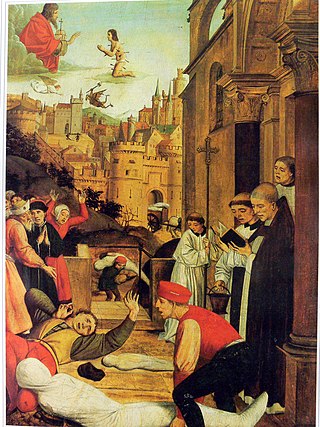
The first plague pandemic was the first historically recorded Old World pandemic of plague, the contagious disease caused by the bacterium Yersinia pestis. Also called the early medieval pandemic, it began with the Plague of Justinian in 541 and continued until 750 or 767. At least fifteen to eighteen major waves of plague following the Justinianic plague have been identified from historical records. The pandemic affected the Mediterranean Basin most severely and most frequently, but also infected the Near East and Northern Europe, and potentially East Asia as well. The Roman emperor Justinian I's name is sometimes applied to the whole series of plague epidemics in late antiquity.

The second plague pandemic was a major series of epidemics of plague that started with the Black Death, which reached medieval Europe in 1346 and killed up to half of the population of Eurasia in the next four years. It followed the first plague pandemic that began in the 6th century with the Plague of Justinian, but had ended in the 8th century. Although the plague died out in most places after 1353, it became endemic and recurred regularly. A series of major epidemics occurred in the late 17th century, and the disease recurred in some places until the late 18th century or the early 19th century. After this, a new strain of the bacterium gave rise to the third plague pandemic, which started in Asia around the mid-19th century.
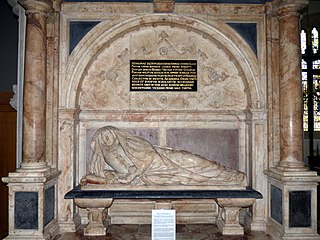
Elizabeth Bacon was an English aristocrat. She is presumed to have been the Lady Neville of My Ladye Nevells Booke, an important manuscript of keyboard music by William Byrd, which was compiled in 1591. She was the daughter of Queen Elizabeth's Lord Keeper of the Great Seal, Sir Nicholas Bacon, by his first wife, Jane Ferneley. She was, successively, the wife of Sir Robert D'Oylie, the courtier Sir Henry Neville, and the judge Sir William Peryam.

From 1592 to 1593, London experienced its last major plague outbreak of the 16th century. During this period, at least 15,000 people died of plague within the City of London and another 4,900 died of plague in the surrounding parishes.
Globally about 600 cases of plague are reported a year. In 2017 and November 2019 the countries with the most cases include the Democratic Republic of the Congo, Madagascar, and Peru.
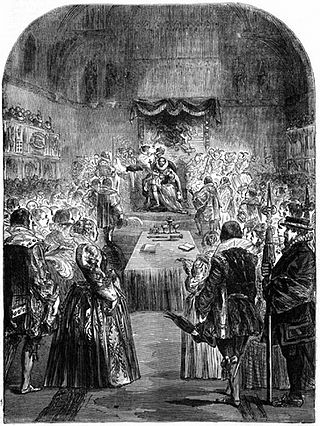
The 1603 London plague epidemic was the first of the 17th century and marked the transition from the Tudor to the Stuart period.
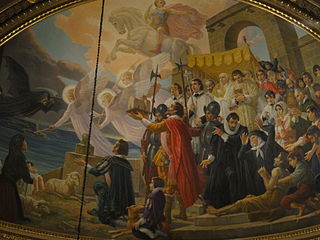
The 1675–1676 Malta plague epidemic was a major outbreak of plague on the island of Malta, then ruled by the Order of St John. It occurred between December 1675 and August 1676, and resulted in approximately 11,300 deaths, making it the deadliest epidemic in Maltese history. Most deaths were in the urban areas, including the capital Valletta and the Three Cities, which had a mortality rate of about 41%. In the rural settlements, the mortality rate was 6.9%.

In 1557, a pandemic strain of influenza emerged in Asia, then spread to Africa, Europe, and eventually the Americas. This flu was highly infectious and presented with intense, occasionally lethal symptoms. Medical historians like Thomas Short, Lazare Rivière and Charles Creighton gathered descriptions of catarrhal fevers recognized as influenza by modern physicians attacking populations with the greatest intensity between 1557 and 1559. The 1557 flu saw governments, for possibly the first time, inviting physicians to instill bureaucratic organization into epidemic responses. It is also the first pandemic where influenza is pathologically linked to miscarriages, given its first English names, and is reliably recorded as having spread globally. Influenza caused higher burial rates, near-universal infection, and economic turmoil as it returned in repeated waves.

In 1580 a severe influenza pandemic was recorded on several continents. The virus originated in Asia and spread along the Silk Road through the Middle East into Europe and Africa, where newly established maritime trade routes and moving armies facilitated its worldwide spread. Contemporary historian Johann Boekel wrote that it spread over all of Europe in six weeks, in which thousands died and nearly everyone was infected. Those who witnessed the epidemic variously called the disease nicknames like coqueluche,Shaufkrankeit,castrone, or variations of catarrh or fever. Physicians of the time increasingly appreciated that "epidemic catarrhs" were being directly caused by a contagious agent instead of the stars or environment.
The 1623 Malta plague outbreak was a minor outbreak of plague on the island of Malta, then ruled by the Order of St John. It was probably caused by infected materials from a major epidemic in 1592–1593, and it was successfully contained after causing 40 to 45 deaths.

















